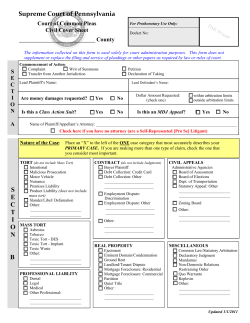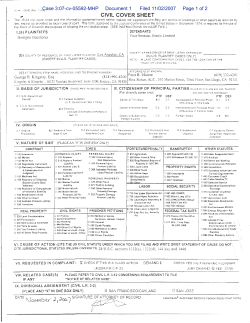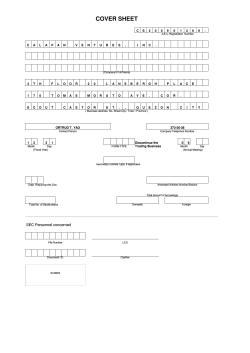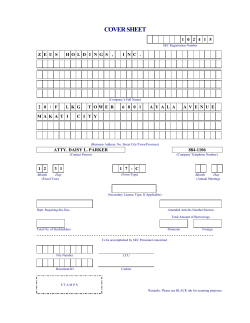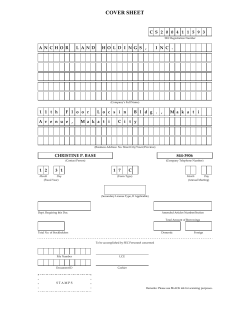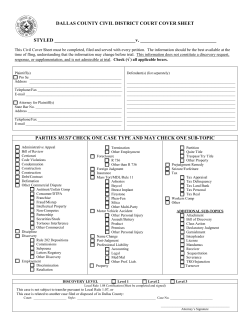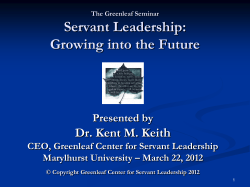
SAMPLE QUESTION PAPER BAR COUNCIL OF INDIA
BAR COUNCIL OF INDIA SAMPLE QUESTION PAPER ALL INDIA BAR EXAMINATION - 4 SAMPLE QUESTION PAPER AIBE 4 1. A) B) C) D) The structure of Indian Constitution is? Federal in form and unitary in spirit. Unitary. Unitary in form and federal in spirit. Purely federal. 2. A) B) C) D) “The Constitution establishes a system of government, which is almost Quasi-federal” , This statement relates to? Sir Jennings. Dr. B.R. Ambedkar. Prof. K. C. Wheare. Dr. Rajendra Prasad. 3. A) B) C) D) In whose time period, the Panchayats were given the Constitutional status? Rajiv Ghandhi. Chandrashekhar. V.P. Singh. P.V. Narsimha Rao. 4. A) B) C) D) Which one of the following statement correctly describes the Fourth Schedule of the Constitution of India? It lists the distribution of powers between the union and the states. It contains the language listed in the Constitution. It contains the provisions regarding the administration of tribal areas. It allocates seats in the Council of States. 5. A) B) C) D) Who described the Part III of the Indian Constitution as “most criticized part of the Constitution”? Jawahar Lal Nehru. B.R. Ambedkar. Dr. Rajendra Prasad. B.N.Rau. 6. A) B) C) D) When an Enactment is of such a nature that no separation is possible between inconsistent and consistent part? Whole Act will be operative. Whole Act will be inoperative. The Act will neither be operative nor inoperative. None of these. 7. A) B) C) D) For which of the following, special provisions can be made under Article 15 of the Constitution of India? Women and Children. Scheduled and Tribes. Economically Backward Classes. Socially Backward Classes. 8. A) B) C) D) Under which law the ‘untouchability’ has been declared abolished in India? Protection of Civil Rights Act. Schedule Castes and Schedule Tribes Act, 1989. Constitution of India. All of the above. 9. The Supreme Court has held in a case that Mrs. Sonia Gandhi,the President of Congress(I) is not an Italian citizen, but is an Indian citizen under: Article 10. Article11. The citizenship Act, 1955. None of the above. A) B) C) D) 1 SAMPLE QUESTION PAPER AIBE 4 10. A) B) C) D) Constitution is generally defined as? Law of the land. Fundamental law of the land. Administrative law of the land. Constitutional law of the land. 11. A) B) C) D) Judgment under Sec.2 (9) means A decree formally expressed. A decree informally expressed. Statements of grounds of an order or decree. The relief granted. 12. Which of the following is not a pleader? A) An Advocate. B) A Vakil. C) An Attorney of high court. D) Recognized agent. 13. A) B) C) D) Which of the following suits is not of a civil nature: Suits relating to right to property. Suits relating to right to worship/ to share In offerings. Suits relating to taking out of religious procession. Suits for recovery of voluntary payments or offerings. 14. In which of the following cases, Sec 10 will apply? A) Where the earlier suits was for recovery of rent for a certain period and the subsequent suits is for recovery of rent for subsequent years and for ejectment. B) ‘B’ is a merchant residing in Delhi, and he has an agent, ‘A’ at Mumbai, to sell his goods in Mumbai. ‘A’ sues ‘B’ in Mumbai, claiming a balance due upon an account in respect of dealings between ‘A’ and ‘B’. While this suits is pending in Mumbai, ‘B’ files a suits against ‘A’ in Delhi for an account and for damages caused by A’s alleged negligence. C) The previous suits is for mens profits and the subsequent suits is for title. D) All of the above. 15. Which Explanation to Sec 11 refers to cases in which a decision in a suit may operate as res judicata against persons not expressly named as parties to the suits. A) Explanation II to Sec. 11. B) Explanation III to Sec. 11. C) Explanation IV to Sec. 11. D) Explanation VI to Sec. 11. 16. In which of the following cases, res judicata is not applicable? I. A judgment against which an appeal has been field. II. Consent/ compromise decree. III. Ex parte decree. IV. An obiter dictum. V. When the earlier decision is opposed to the provision of a statute. VI. Public interst cases. VII. A judgment obtained by fraud or collusion. Codes: A) I, II and III. B) II, IV and VI. C) I, II, IV, V, VI and VII. D) II, III, IV, V, VI and VII. 2 SAMPLE QUESTION PAPER AIBE 4 17. X is living in Pune and Y, his brother in Mumbai. X wants to file a suit for partition of their joint property situated in Delhi and Bangalore. A) The suit may be instituted in Delhi only. B) The suit may be instituted in Bangalore only. C) The suit may be instituted either in Delhi or Bangalore. D) None of the above. 18. A) B) C) D) Where two or more Courts having the jurisdiction, the jurisdiction of a civil courts under Sec. 20, C.P.C.: Can be excluded by a clear agreement between the parties. Cannot be excluded under any circumstance. Can be excluded by a court’s order. None of the above. 19. A suit is transferred by the Supreme Court from one court ‘A’ to another court ‘B’ Meanwhile, during the transfer, the law applicable to the suit got changed. A) The original law which was to be applied by the court ‘A’ has to be applied by the court ‘B’. B) The original law which was to be applied by the court ‘A’ is not to be applied by the court ‘B’. C) The court ‘B’ is required to consider the stage at which the suit was transferred for determining the applicability of old or new law to it. D) Both (b) and (c). 20. In a suit instituted in England on the basis of a contract made in India, the English Court applied English law. The judgment of the court is: A) Conclusive. B) Not conclusive. C) Not conclusive; the rights and liabilities of the parties to a contract are governed by the place where the contract is made. D) Conclusive because the rights and liabilities of the parties to a contract are governed by the place where a suit is filed for a breach of the contract. 21. A) B) C) D) When the Criminal Procedure Code, 1973 came into force? On April 1, 1973. On April 1, 1974. On January 1, 1974. On March 1, 1974. 22. In a First Information Report, an offence is cognizable and other is non cognizable, the whole case shall be deemed to be? A) Cognizable. B) Non-cognizable. C) It is to be seen whether it is a warrant case. D) It is to be whether it is a summons case. 23. A) B) C) D) A Metropolitan Magistrate is equivalent to? Judicial magistrate of the First Class. Judicial magistrate of the Second Class. Jither (a) and (b). None of the above. 24. A) B) C) D) For appointment of a Special Public Prosecutor, how many years of experience is required as a practicing Advocate? 7 years. 10 years. 15 years. 5 years. 3 SAMPLE QUESTION PAPER AIBE 4 25. Which of the following sentence may be passed by a Magistrate of Second Class? A) Imprisonment for a term not exceeding two years. B) Imprisonment for a term not exceeding one years. C) Imprisonment for a term not exceeding six months. D) Only a fine not exceeding five thousand rupees. 26. Any Police Officer may not without an order from Magistrate and without a warrant, arrest any person? A) Who has been concerned in any non cognizable offence B) Who has been accused of committing a non-cognizable offence refuses to give his name and address. C) Who has been a released convict D) Who has been in possession of any implement of house-breaking 27. If a person in lawful custody escapes, the person from whose custody he escaped may immediately pursue and him? A) Within local limits of the police station concerned. B) Within local limits of the district. C) Within local limits of the state. D) In any place in India. 28. A person arrested by a police officer may be kept in custody for? A) 2 years. B) 3 years. C) 24 hrs. D) 1 week. 29. When a court desires that a summons issued by it shall be served at any place outside its local Jurisdiction is shall ordinarily send such summons in duplicate to? A) Magistrate of Competent Jurisdiction. B) Inspector of such local officer. C) Either of the above two. D) All of the above. 30. Which is not the main principle that underlines the law of Evidence? A) Evidence must be confined to the matters In issue. B) Hearsay Evidence must not be admitted. C) Hearsay Evidence must not be admitted. D) The best Evidence must be given in all cases. 31. Under the Indian Evidence Act, the term ”fact” includes? A) Facts in issue and relevant facts. B) Principal facts and evidentiary facts. C) Factum probandum and factum probans. D) All of the above. 32. A is accused of a child’s murder. The following facts are constructed in the case? 1. An hour before the murder, A went to the place of murder with the child. 2. Alone returned home. 3. A’s cloth were found to be blood-stained. The Evidence which takes into account the above-mentioned facts is called? A) Direct Evidence. B) Circumstantial Evidence. C) Real Evidence. D) Secondary Evidence. 4 arrest SAMPLE QUESTION PAPER AIBE 4 33. The questions whether A murdered B during the course of a struggle. Marks on the ground produced by the straggle at the place of occurrence are a relevant fact which section of the Evidence Act? A) Sec. 6. B) Sec. 7. C) Sec.8. D) Sec. 10. 34. The question is, whether A was ravished .the fact that, shortly after the alleged rape, A made a complaint relating to the offence is a? A) Relevant fact showing conduct. B) Relevant fact showing motive. C) Ract in issue. D) None of the above. 35. The Plea of Alibi is governed by which section of the Evidence Act? A) Sec12. B) Sec 11. C) Sec 13. D) Sec 14. 36. Which of the following statement is correct? A) Admission could be oral only. B) Admission could be documentary only. C) Admission could be documentary or oral. D) Admission are conclusive proof of the matters admitted. 37. Opinion of an expert is? A) Relevant but unsafe. B) A conclusive proof. C) Supportive and corroborative in nature. D) Both (a) and (c) 38. The communication of a revocation , as against the person who makes it , is complete : A) When it is put into a course of transmission so as to be out of the power of the person who makes it. B) When it comes to the knowledge of the person to whom it is being made. C) When the person to whom it is being made , signifies his assent thereto. D) All of the above. 39. An Agreement is : A) Every promise and every set of promises forming the consideration for each other. B) Every promise to do something or to abstain from doing something. C) Signification by one person of the intention to abide by the promise. D) Promise against a promise. 40. Which of the following statement is correct: A) A lunatic person can never enter into a contact. B) A lunatic person is legally capable of entering into a contract at any time. C) A lunatic person should not enter into a contract. D) A lunatic person , who is at intervals of sound mind, may contract during those intervals. 41. The carlill v. carbolic smoke ball co., case is related to : A) Offer and counter offer B) Offer to public at large C) Invitation to offer to public at large D) Offer and revocation of offer 5 SAMPLE QUESTION PAPER AIBE 4 42. Stop where repayment begins “, can be applied with respect to : A) Minors only B) An alien enemy only C) Lunatics and idiots only D) Any incapable person 43. The agreement entered into by a minor is : A) Null and void contract B) Voidable contract , at the option of the minor C) Valid and enforceable contract D) Not a contract at all 44. When goods are displayed in a show-window bearing price-tags, it indicates: A) An invitation to visit the show-room and see the new products launched B) An offer to see goods at prices mentioned on the price tags C) An advertisement to lure ,ore customers D) An invitation to make an offer 45. What will be effect of mistakes as to law in force in India on the agreement ? A) Not voidable B) Voidable C) Void D) Not 46. ‘A’, for natural love and affection, promises to give his son , ‘B’ Rs.1000/-. This is: A) A valid contract and is enforceable B) A void agreement for the want of seriousness of the parties C) Not a contract due to non-fulfillment of the technical requirement of the relevant provision of Contract Act D) A voidable contract at A’s option 47. The nature of the Specific Relief Act is: A) Remedial in nature. B) Protective in nature. C) A procedural law. D) All of these. 48. The basis of Specific Relief Act is: A) Law of equity B) Common law C) Roman law D) All of the above. 49. Specific Reliefs under the Act could be in the form of: A) Rectification of instruments. B) Declaratory decree. C) Injunctions. D) All of the above. 50. Specific Relief under the Act: A) B) C) D) Covers possession of immovable property only. Covers possession of movable property only Both (a) and (b) Only (a) 6 SAMPLE QUESTION PAPER AIBE 4 51. A suit for recovery of possession under Section 6 cannot be filed against : A) A private individual B) A company C) A government D) A firm 52. Section 10 of the Specific Relief Act, 1963 provides for : A) The contracts which can be specifically enforced B) The contacts which cannot be specifically enforced C) Specific performance of a part of the contract D) None of these 53. Specific Performance of a part of the Contract , has been dealt with under : A) Section 9 of the Specific relief Act, 1963 B) Section 10 of the Specific Relief Act,1963 C) Section 11 of the Specific Relief Act ,1963 D) Section 12 of the Specific Relief Act , 1963 54. Which Section of the Specific relief Act provides for rights of purchaser or lessee against person with imperfect respect of immovable property: A) Sec. 13 B) Sec. 14 C) Sec. 15 D) Sec. 16 title in 55. In which of the following cases, the Specific performance of a contract is not possible: A) A contract to give in marriage. B) An agreement by an eminent professor of constitutional law to deliver a course of lectures at the Delhi University. C) A contracts to supply B with all the goods of a certain class which B may require in future D) All of the above 56. Which of the following is a defence to a suit for Specific performance of a contract which, if permissible , may be set up by a defendant : A) Unfair advantage to the plaintiff B) Hardship to the defendant C) Fraud or mistake D) All of the above 57. The term ‘offence’ means? A) A thing made punishable by the penal code. B) A thing made punishable by the penal code or any special or local law, in certain case. C) Both (i) and (ii). D) None of above. 58. In which of the following, means rea is not essential? A) Strict or absolute liability. B) Public nuisance. C) Ignorance of law is no excuse-maxim. D) All are correct. 59. Which of the following cases is related to’ joint liability’? A) R.V Arnold. B) Mehboob Shah V Emperor. C) R.V. Heyens. D) R.Vprince. 7 SAMPLE QUESTION PAPER AIBE 4 60. Irresistible impulse? A) Does not come under insanity. B) Does come under insanity. C) In special circumstances only. D) None of the above. 61. ‘A’ with the intention of murdering Z instigates B to give poison to Z. B, however, takes poison himself. A) A is guilty of abetment. B) A is guilty of causing death of lunatic (B). C) A is not guilty as B, a lunatic, cannot be an offender in the eyes of law. D) None of these. 62. ‘A’ entered into an agreement with ‘B’ to obtain undue favour from public servant ‘C’ on the promises that ‘A’ will be pay 1 lakh to ‘B’, who will deliver the same to ‘C’. ’A’ and ‘B’ did so, but ‘C’ refused to do any favour. A) ‘B’ is alone responsible for his action. B) Both ‘B’ and ‘C’ are liable as there was abetment by conspiracy. C) ‘C’ alone is responsible as he misappropriated the money. D) None of these. 63. The relation of Jurisprudence into general and particular Jurisprudence? A) Austin B) Gray C) Salmond D) Holland 64. Who defined jurisprudence as ‘part of history, a part of economic and sociology, a part of ethics and philosophy of life’? A) Arnold B) Austin C) Pound D) Radcliff 65. The apostle of individualism was destined to become the founder of state socialism’. The above statement by dicey refers to A) Austin B) Bentham C) Savigny D) Maine 66. Arbitration is akin to: A) Panchayat B) Lok Adalats C) A form of conciliation D) Both (a) and (b) 67. Which of the following is not a characteristic of an arbitration proceeding: A) Quickness of decision, simplicity of procedure and inexpensiveness. B) A judicial proceeding. C) Involvement of arbitrator. D) Non – interference of court till the arbitral award is made. 68. An arbitration proceeding is a: A) Judicial proceeding B) Quasi-judicial proceeding C) Administrative proceeding D) None of the above 8 SAMPLE QUESTION PAPER AIBE 4 69. Which of the following is a mode of arbitration in existence today: A) Online arbitration B) Fast track arbitration C) Ad-hoc arbitration D) All of the above 70. For the Law of Limitation which is the incorrect statement: A) Bars the judicial remedy. B) Does not extinguish substantive right. C) Is an adjective or procedural law. D) Creates a right in favour of a person. 71. Where no period is prescribed for exercise of power in statute like Limitation Act, such power must be exercised: A) Within reasonable time. B) Within minimum time. C) Within maximum time. D) Depends upon the court’s discretion. 72. Option of Puberty as a ground for divorce is available to the wife under the Dissolution of Muslim Marriage Act, 1939. A) When the marriage has not been consummated B) When the marriage has been consummated C) Irrespective of whether the marriage has been consummated or not D) Only (a) and (b). 73. Option of Puberty as a ground for divorce to the Muslim wife has been provided under: A) Section 2(v) of the Dissolution of Muslim Marriage Act , 1939 B) Section 2(iii) of the Dissolution of Muslim Marriage Act,1939 C) Section 2(vii) of the dissolution of Muslim Marriage Act, 1939 D) Section 2(ix) of the Dissolution of Muslim Marriage Act, 1939. 74. Acknowledgement of Paternity cannot be made in respect of offspring of: A) Incest B) Adultery C) Fornication D) All the above. 75. Which of the following are the grounds of declaring a marriage void under the Parsi Marriage and Divorce Act 1936: A) Impotency B) Prohibited degree of relationship C) No-performance of Ashirbad D) Bigamy 76. Injuria sine Damnum relates to cases where there is: A) An invasion of an absolute private right B) An invasion of a public right C) A violation of a legal right D) A legally authorised Act resulting in injury 77. In Haynes v. Harwood case, the servant of X left a horse van unattended on a street. A boy threw stone at the horse who get frightened and bolted. This constituted a grave danger to the woman and the children on the road. A police constable perceiving this danger managed to stop the horse but was himself injured. He came up for a claim in tort against X. The claim: A) Succeeded because the Constable acted under an exigency caused by wrongful conduct of the servant of X B) Failed because X had no hand in injuring the Police Constable C) Failed on the ground of volenti non fit injuira as the constable perceived the risk before he wnt to rescue D) Failed because it was the action of the boy and not the fault of the servant of X that the horse bolted. 9 SAMPLE QUESTION PAPER AIBE 4 78. Doctrine of Common employment means: A) If a servant commits tort against strangers, master is not liable B) If a servant commits tort against his fellow servant, the master is liable C) If a servant commits tort against his fellow servant , master is not liable D) If a servant commits tort against the servant of another master then the master is not liable for the tort committed by his servant 79. A Railway Company was authorised by law to run railway trains on a track. The spark from the engine set fire to the adjoining property belonging to plaintiff. Which of the following defenses can be taken by the railway company in an action for nuisance by the plaintiff: A) Inevitable consequence In exercise of one’s legitimate business B) Plaintiff himself negligent in keeping the property adjoining to the railway tracks C) Public good being done by running the trains D) Statutory authority. 80. The plaintiff was resting her elbow on the window-still of the bus while travelling on it. A truck coming from the opposite direction hit her in her elbow as a result of which she received severe injuries. Otherwise the truck did not come into any contact with the bus. In this case: A) The bus driver is liable because it was his duty to pass the bus with a reasonable passengers’ habit of resting their elbow on the window of the bus. B) The bus driver is not liable because the plaintiff is herself guilty of contributory negligence in carelessly resting her elbow on the window of the bus C) The driver is not liable as it is not foreseeable that a passing vehicle from other direction can hurt the passenger of the bus D) The bus driver is not liable but the truck driver is liable who actually injured plaintiff elbow 81. Following is not a valid defence in a suit for tort of nuisance I. Prescription II. Public good III. Reasonable care taken by the name defendant IV. Statutory Authority V. Plaintiff coming to nuisance Mark the correct option A) I , III and V B) II , IV and V C) II, III and V D) I , II and IV 82. The fact that the defendant had reputed the contract and refused to perform his part of the bargain: A) Will not relieve the plaintiff of his obligation to perform his part of the contract. B) Will relieve the plaintiff of his obligation to perform his part of the contract. C) Depends on the court’s discretion. D) None of the above. 83. The display of articles in a showroom indicating their prices amounts to: A) Offer to sell articles at price mentioned. B) Counter offer. C) Invitation to an offer. D) Mere advertisement. 84. The first Factories Act was enacted in A) 1881 B) 1895 C) 1897 D) 1885 10 SAMPLE QUESTION PAPER AIBE 4 85. The space for every worker employed in the Factory after the commencement of Factories Act, 1948 should be ________ Cubic Meters. A) 9.9 B) 10.2 C) 14.2 D) 13.2 86. Leave with wages is allowed for employees if they work for _______ days in a month. A) 15 B) 25 C) 20 D) 28 87. Section 2 (K) of the Factories Act 1947 relates to: A) Manufacturing Process B) Factory C) Worker D) None of these 88. The term Sabbatical is connected with A) Paid leave for study B) Paternity leave C) Maternity leave D) Quarantine leave 89. For contravention of provisions of Factories Act or Rules, the occupier shall be liable for punishment up to A) 2 years or fine up to Rs.1,00,000 or both B) 6 months or fine upto 10, 000 or both C) 3 three years or fine 10, 000 or both D) None of these 90. _____________agencies are established to provide regulation. A) Executive B) Judicial C) Law-abiding D) Administrative 91. Statements of ___________announce a proposed course of action that an agency intends to follow in the future. A) B) C) D) Policy Convictions Intent Interpretation 92. Which of the following is NOT a condition that must be satisfied before a petitioner can appeal an action of an administrative agency? A) The petitioner must have paid all the attorneys' fees and court costs. B) The case must be ripe for review. C) The petitioner must have exhausted all administrative remedies. D) The decision of the administration agency must be final before a judicial review can be sought. 11 SAMPLE QUESTION PAPER AIBE 4 93. Address of the registered office is situated in Choose one: A) MOA B) AOA C) Prospectus D) None of these 94. In the MOA there are 6 classes. We can alter all clauses expect one clause. What is that clause? Choose one: A) Objects clause B) Name clause C) Association clause D) None of these 95. Any company can be wind off by the: Choose one: A) Voluntary B) Court C) Both D) None of the above. 96. MOA should be in form ________ in case of company limited by guarantee and having share capital Choose one: A) Table A B) Table B C) Table C D) Table D 97. A contract was signed b/w an Indian and yogoslavian party. One of the terms provided for arbitration. Immediately thereafter the Indian party cabled and objected about the arbitration clause .the other party made no reply to it, but permitted the work to go on. A dispute arose between the parties. A) The arbitration clause had not become deleted from the contract. B) The arbitration clause had become deleted from the contract by an implied agreement. C) The arbitration clause had not become deleted from the contract as the other party did not objected to it. D) None of these above. 98. The communication of an offer or proposal is complete A) When it comes to the knowledge of the person to whom it is made. B) When the letter containing the proposal is put in the course of transmission. C) When the person to whom the proposal is made reads the letter. D) When the proposal is communicated to the person to whom it is made. 99. X , An employer deducts a certain percentage from the salary of his employees telling that it is their contribution to the provident fund but fails to credit it in the fund. X commits: A) Theft B) Criminal breach of trust C) Cheating D) Criminal misappropriation. 100. In which of the following cases, a firm will not be liable for the wrongful Act or omission of a partner A) A partner of a firm while acting in the ordinary course of business colluded with a partner of another firm causing loss to the other firm B) A partner acting within the scope of his implied authority, raised money by drawing bills in a fictitious name , and he used the money in the firm’s business C) Receipt of money, due to the firm, by one of the partners by way of set off against his personal ebt to the other party D) None of the above. 12
© Copyright 2025

